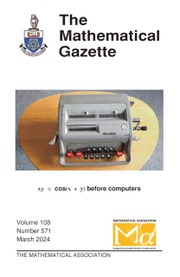No CrossRef data available.
Article contents
On HAP triangles
Published online by Cambridge University Press: 20 June 2025
Extract
It is a well known and easily verifiable fact that not all integer triangles have integer areas. Consider the triangles with sides {9, 10, 17}, {13, 14, 15}, {5, 7, 8} and {6, 7, 9} with respective areas 36, 84,  and
and  . The first two, whose areas are integers, are called Heronian triangles. The second triangle also has the additional property that its sides are consecutive integers and is an example of a Brahmagupta triangle, named after an Indian mathematician, born in AD 598. These are called Super-Heronian triangles in [1] and a method is developed there for generating examples of such triangles.
. The first two, whose areas are integers, are called Heronian triangles. The second triangle also has the additional property that its sides are consecutive integers and is an example of a Brahmagupta triangle, named after an Indian mathematician, born in AD 598. These are called Super-Heronian triangles in [1] and a method is developed there for generating examples of such triangles.
Information
- Type
- Articles
- Information
- Copyright
- © The Authors, 2025 Published by Cambridge University Press on behalf of The Mathematical Association
References
Richardson, William H., Super-Heronian triangles (2010), available at https://www.math.wichita.edu/~richardson/heronian/heronian.html
Google Scholar
MacDougall, J. A, Heron triangles with sides in arithmetic progression, Jour. Rec. Math. 31 (2003) pp. 189–196.Google Scholar
Bailey, Herb and Gosnell, William, Heronian triangles with sides in arithmetic progression: an inradius perspective, Maths Magazine, 85 (October 2012) pp. 290–294.CrossRefGoogle Scholar
Read, Emrys, On the class of an integer triangle, Math. Gaz. 106 (July 2022) pp. 291–299.Google Scholar


